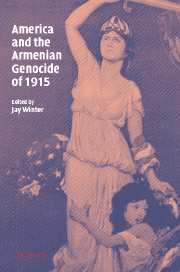Book contents
- Frontmatter
- Contents
- List of contributors
- Map
- Acknowledgments
- Introduction: witness to genocide
- Part 1 The framework
- Part II During the Catastrophe
- Part III After the Catastrophe
- 10 The Armenian Genocide and US post-war commissions
- 11 Congress confronts the Armenian Genocide
- 12 When news is not enough: American media and Armenian deaths
- Index
- Studies in the Social and Cultural History of Modern Warfare
11 - Congress confronts the Armenian Genocide
Published online by Cambridge University Press: 04 September 2009
- Frontmatter
- Contents
- List of contributors
- Map
- Acknowledgments
- Introduction: witness to genocide
- Part 1 The framework
- Part II During the Catastrophe
- Part III After the Catastrophe
- 10 The Armenian Genocide and US post-war commissions
- 11 Congress confronts the Armenian Genocide
- 12 When news is not enough: American media and Armenian deaths
- Index
- Studies in the Social and Cultural History of Modern Warfare
Summary
The United States Congress's inability to come to terms with the Armenian Genocide underscored its limited role in American foreign policy. Under the constitutional system of division of powers, with its checks and balances, the executive branch has traditionally taken the lead in shaping foreign policy. Presidents have regularly made major policy decisions without prior consultation with Congress. The national legislature has exerted its influence chiefly through the power of the purse – by appropriating funds needed to carry out the policy – and through the Senates confirmation of diplomatic appointments and its approval or rejection of treaties. Congress can legislate to mandate or restrict executive branch actions, especially if it can muster the two-thirds vote to override a presidential veto. Either jointly or separately, either house of Congress can also declare its positions on issues through formal resolutions, which Presidents may embrace or ignore. Being divided between two legislative bodies, and further between two political parties that lack the political discipline of a parliamentary system, Congress has needed to build consensus on each new complex and controversial issue. It proceeds by holding hearings and taking testimony, using the collected evidence to formulate bills and resolutions and then debating the proposals and amending them if necessary to gain majority support in both the Senate and House of Representatives. Congressional hearings, debates, and statements to the news media are further intended to educate and sway public opinion.
- Type
- Chapter
- Information
- America and the Armenian Genocide of 1915 , pp. 276 - 293Publisher: Cambridge University PressPrint publication year: 2004

